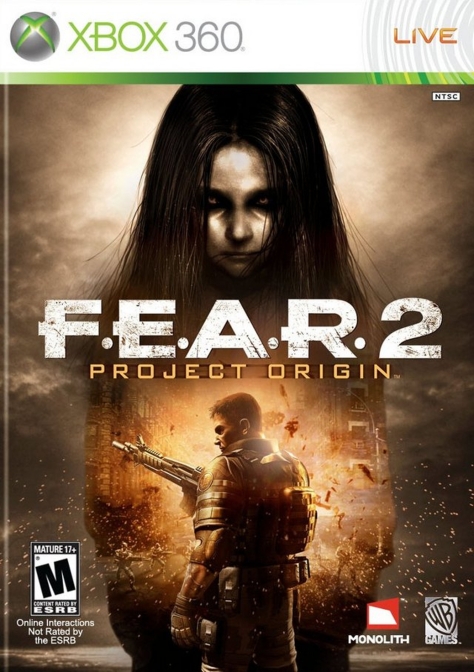
As I engaged with allies, enemies, and explored the first few missions of F.E.A.R. 2: Project Origin, I couldn’t get over how good it looked. The visual detail present in character models and environments floored me. It was a remarkable improvement over F.E.A.R. and its two expansions, which released upwards of three-and-a-half years prior. Monolith Productions developed the first game during a transition period between console generations, while this entry was put together firmly within one, and it showed. That further familiarity with development tools and the platforms of release resulted in visual improvements isn’t surprising, however. But, personally it was a reminder of how good games of the previous generation could look, and how much improvement had been made in just a few years.
F.E.A.R. 2: Project Origin released on the PC, PlayStation 3, and Xbox 360 on February 10, 2009, the latter being the version I played. Unlike the previous iterations which were published by Vivendi Games, by way of their Sierra Entertainment brand, this was the first to be published by Warner Bros. Interactive Entertainment, Monolith’s parent company as of early 2004. Like the non-canonical expansions for the first game, this entry began in the climactic final moments of its predecessor. To refresh, the Point Man triggered an explosion destroying the secret research facility where Alma’s corpse was contained, leveling much of the surrounding Cascadian city of Fairport. Elsewhere, just before this calamity, a Delta Force squad stormed the penthouse of Genevieve Aristide, the president of Armacham Technology Corporation, the defense contractor behind everything. All hell broke loose in the wake of the explosion.

Michael Becket, my avatar, and his fellow Delta Force members woke up in a hospital afterwards. They’d come to find out that Aristide, whose Machiavellian ways were exposed through voicemails in the previous game, didn’t have their best interests in mind. Beckett in particular was gifted with the now series standard slow-motion ability. This was a boon in gunfights against ATC’s clean-up crews and Replica soldiers reactivated by Alma. Unfortunately, whatever she did also telepathically linked Becket and his cohorts to Alma. As they fought through the destroyed city, uncovering what Aristide had been up to and setting out to put an end to it, they were subjected to Alma’s rage. To quote Snake Fist, the Otacon-like fellow who aided the squad “You’re like free pizza at an anime convention. She can smell you. And she wants to consume you.”
Now, nowhere in my summarization of the setup have I mentioned a F.E.A.R. unit or any direct connection to persons with firsthand experience of what happened in the original game. That’s because there was none. Sure, chronologically those events just happened, but this little wrinkle allowed for Alma’s origin story and the extent of her abilities to be retold, as though it was being heard for the first time. For this Delta Force squad it was, although it was all old hat to me. No question, I was letdown. I appreciated that many of the background aspects were fleshed out and framed better, instead of simply listening to voicemails as in the first game, yet there wasn’t much moving the series forward, from a narrative perspective. With the exception of the bonkers ending, that is. Seriously, if you’re not going to play this, do me a favor and just read the last paragraph of the game’s plot section on Wikipedia.

I mentioned at the start how much the visuals impressed me. They were a marked improvement upon the original F.E.A.R., if only from a technical standpoint. But a lot of my feelings can also be contributed to the environmental variety. That game was very much a corridor shooter set in, like, three environments. There’s nothing wrong with that, either; the developers exceeded in giving pedestrian settings a uniquely sinister atmosphere. Similar locales and moments were present in this entry, though there was a greater emphasis on action. In this way and among others the presence of allies, the evolution of the F.E.A.R. series paralleled the transition of the Alien films: from the horror-centric Alien to the action-oriented Aliens.
Much more prevalent were expansive environments like the crumbling city streets of Fairport or cavernous facilities where ATC secretly carried out operations. These settings were more conducive to long-range gunplay, so I had to rely more on assault and sniper rifles than my favorite pairing of shotguns and slow-motion. Many of the futuristic weapons from the previous entries were missing and on the whole, the available arsenal was rooted in reality; or, near-future reality, given the inclusion of mechs. A few missions put me in the pilot’s seat of ground-based mechs, harking back to Monolith’s 1998 PC game Shogo: Mobile Armor Division. Shredding infantry and blasting other mech combatants was exciting. So too was manning the turret of the squad’s APC when the opportunity arose. Nonetheless, when sequences like these occurred, I thought this game felt a little less unique among the field of first-person shooters.

Whereas F.E.A.R. felt like a horror game that happened to be a first-person shooter, this entry felt like a first-person shooter than happened to have horror elements. Monolith Productions balanced the two exceptionally well in the first game, but the scales were uneven in F.E.A.R. 2: Project Origin. To be sure, there were still sequences that elicited fear. For instance, the squad’s traipse through a wrecked grade school in dire need of an electrician, and the Ghostbusters. Still, the formula felt out of whack. That section also highlighted improvements they had made in conveying information. Specifically, uncovering ATC’s connection to the school, and listening to Becket’s colleagues piece it together in real-time. And yet, on the whole the overarching story for the series didn’t progress, it was merely further fleshed out. F.E.A.R. 2 looked sharp, played great, and kept me entertained, but it wasn’t as special as the first game.

2 thoughts on “F.E.A.R. 2: Project Origin [Xbox 360]- Review”